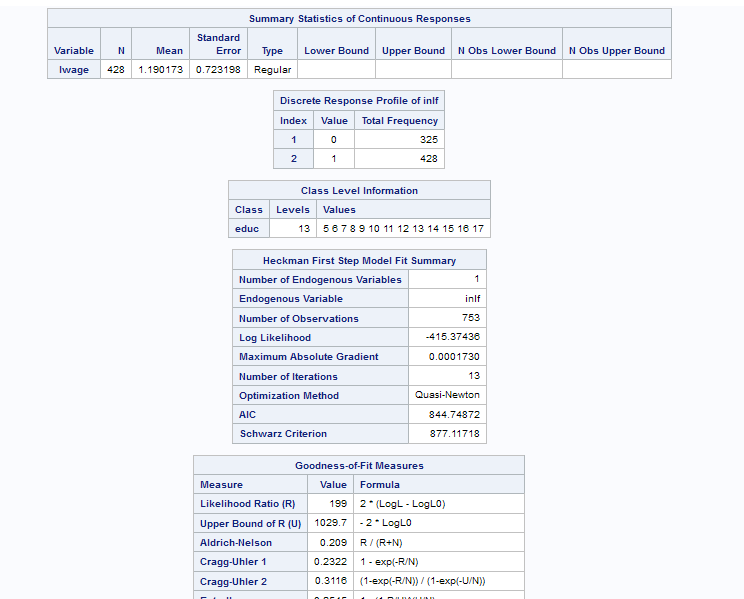Heckman Selection Model Task
About the Heckman Selection Model Task
The Heckman two-step
selection method provides a means of correcting for non-randomly selected
samples. It is a two-stage estimation method. The first stage performs
a probit analysis on a selection equation. The second stage analyzes
an outcome equation based on the first-stage binary probit model.
Note: This task is available only
if you are running SAS 9.4 (or later) and SAS/ETS 12.3 (or later).
Example: Heckman Selection Model Task
To create this example:
-
Create the Work.Mroz data set. For more information, see MROZ Data Set.
Assigning Data to Roles
To run the Heckman
Selection Model task, you must assign columns to the Dependent
variable roles for the selection and outcome equations.
|
Role
|
Column Name
|
|---|---|
|
Selection Equation
|
|
|
Dependent
variable
|
specifies a single numeric
column that takes binary values. By default, the task uses samples
where the dependent variable is equal to 1.
|
|
Continuous
variables
|
specifies the independent
columns (or regressors) to use in the model for the selection equation
dependent variable.
|
|
Categorical
variables
|
specifies how to group
the values into levels.
|
|
Include
the intercept
|
specifies whether to
include the intercept in the selection equation.
|
|
Outcome Equation
|
|
|
Dependent
variable
|
specifies a single numeric
column to use.
|
|
Continuous
variables
|
specifies the independent
columns (or regressors) to use in the model for the outcome equation
dependent variable.
|
|
Categorical
values
|
specifies how to group
the values into levels.
|
|
Include
the intercept
|
specifies whether to
include the intercept in the selection equation.
|
Setting Options
|
Option
|
Description
|
|---|---|
|
Methods
|
|
|
Variance
estimation method
|
specifies whether to
calculate the standard errors by using the corrected standard errors
or the OLS standard errors.
|
|
Type of
covariances of the parameter estimates
|
specifies the method
to calculate the covariance matrix of parameter estimates. You can
select the covariance from the outer product matrix, from the inverse
Hessian matrix, or from the output product and Hessian matrices (the
quasi-maximum likelihood estimates).
|
|
Optimization
|
|
|
Method
|
specifies the iterative
minimization method to use. By default, the Quasi-Newton method is
used.
|
|
Maximum
number of iterations
|
specifies the maximum
number of iterations for the selected method.
|
|
Statistics
|
|
|
You can specify whether
the results include the statistics that the task creates by default,
the default statistics and any additional statistics that you select,
or no statistics.
Here is the information
that you can include in the results:
|
|
Copyright © SAS Institute Inc. All rights reserved.

